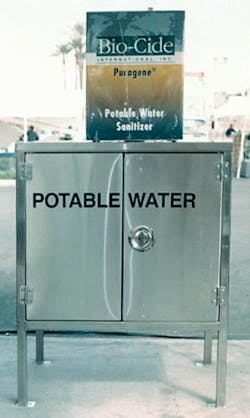In October the EPA announced the finalized Administrative Order On Consent and Request For Information (agreements) with US airlines concerning the onboard drinking water. As many of you know the agreements hold the airlines in violation, halting the approval of those operation and maintenance procedures once used in lieu of monitoring. Instead they require mandatory quarterly testing, as well as equipment and process data submission.
Obviously, increased regulation and monitoring are a reaction to a serious problem in the industry. With a potable water sample coliform positive (bacteria which indicates contamination, often of sewage, but are not pathogens themselves, according to Jim Ringo, director, Bio-Cide International) airlines must stop serving water, turn off the water supply or announce to their customers the water is contaminated and unsafe to drink — not a great ad slogan.
The problems with potable water require better adherence to the EPA guidelines. David Yuhasz, president, AeroSafe Products, says, “All of this, in some way could have been avoided by following the recommendations by the EPA under the current Safe Drinking Water Act. Their recommendations have been in place for quite a few years. Now, there will be a section contained in it aimed specific to airlines and aircraft carrying more than 25 passengers.”
According to Yuhasz, not only will these new regulations cause airlines additional expense because of increased work-hours, equipment and chemical costs incurred to be compliant with the agreement signed by more than 14 airlines, but GSE will also need to perform maintenance and disinfections of that equipment.
Contamination
Sources of water contamination are numerous, many happening from a lack of sanitation. “Dirty water cabinets, cabinet hoses not having their safety caps in place on the ends, build-up of contaminants in water cabinet hoses, hoses dropped and dragged on the ground or touched on the end with dirty hands, or gloves or just a plain bad water source such as wells or waterlines not having enough residual chlorine from the treatment plants,” says Yuhasz, “even airborne bacteria can, in time, contaminate water.”
Preventing this requires correcting the procedures leading to the contamination, changing out cabinet hoses regularly and adding appropriate disinfectants to stop bacteria from growing.
“There is little, if any residual chlorine in water by the time it gets to your tap or at Jetway water cabinets or other point of fill ports. Bacteria will start to grow in less than two hours,” concludes Yuhasz.
Sanitation
Sanitizing the water every time the aircraft and GSE are filled is one way to guarantee safe drinking water. “This can be done by other means of sanitation such as Reverse Osmosis (RO) or ultraviolet light, but none of these processes has a residual effect to control bacteria in the water or to prevent bio-film build-up like chlorine dioxide,” says Yuhasz. (Bio-film grows inside water systems harboring bacteria and pathogens.)
Although chlorine dioxide, commonly sold as Purogene, is not the only disinfectant on the market (Sodium Hypochlorite (chlorine), peroxide, RO, Quats, UV are also ways to kill bacteria), it is the only one to kill the bio-film build-up, indicates Yuhasz. It can be added at 2 PPM to 5 PPM at the point of fill, controlling the growth of bacteria and bio-film, lengthening time between tank maintenance.
Yuhasz adds, “Purogene has the documented efficacy to back up the facts of speed, residual effects, cost of dosage and amount of dosage to destroy bio-film, E.coli and other forms of bacteria in water. I’ll remind you that it was chlorine dioxide that was used to clean up the post offices and Senate office building during the anthrax terrorist acts!”
The new EPA requirements, although straining already stretched airlines, are simply a spotlight on an existing problem with the handling of potable water. Yuhasz adds that medical advancements have no doubt increased life spans and decreased infant deaths, but microbiologists and scientists believe it is the sanitizing and disinfecting of the water supply that has really affected our mortality. That is why revising the operation and maintenance procedures on water systems are necessary to maintain the most basic human need — water.





